The Effect of Incorporating 100% of Undiluted and Diluted Reclaimed Epoxy Asphalt Materials into Pervious Cement Mixes
Abstract
1. Introduction
2. Materials
2.1. Portland Cement
2.2. Silica Fume
2.3. Aggregate
2.4. Reclaimed Epoxy Asphalt Materials
3. Mix Design
4. Specimen Casting
5. Laboratory Tests
5.1. Density Test
- M = the mass of a dry concrete sample in air (g);
- V = the volume of the concrete sample (mm3).
5.2. Permeability Test
- k = permeability coefficient (mm/s);
- a = cross section area of the specimen (mm2);
- l = length of the specimen (mm);
- A = cross-section area of the standpipe (mm2);
- t = recorded time for the water head to change from h1 to h2 (s);
- h1 = initial water head (mm);
- h2 = final water head (mm).
5.3. Compressive Strength
6. Concrete Test Results and Discussion
6.1. Density Test Results
6.2. Void Content
- T = theoretical density (kg/m3);
- D = the bulk density of a concrete specimen (kg/m3).
6.3. Permeability Test Results
6.4. Compressive Strength Test Results
7. Conclusions
- The density test results showed that replacing natural aggregates with either 100% epoxy RAP or 100% diluted epoxy RAP particles reduced the density by an average of 10%. This is consistent with the density results of concrete mixes that contain regular RAP particles and can be explained by the light weight of reclaimed materials compared with the natural aggregate.
- Results showed that adding 5% silica fume to epoxy RAP mixes did not affect the concrete specimen’s density. This is expected as the content of silica fume utilized in this study is only 5% of cement. A larger content, however, may lead to a lower density as it has a lower specific gravity compared with Portland cement.
- Incorporating epoxy RAP and diluted epoxy RAP into cement mixes increased the air content by about 25% on average compared to the natural cement mix, even with the existence of silica fume. This can be interpreted by the high air content in recycled particles compared with natural aggregates.
- Permeability is significantly increased with mixes that have 100% of both epoxy RAP and diluted epoxy RAP materials compared to the natural mix. However, adding silica fume decreased the permeability to a value similar to that of the natural mix. This is due to the existence of microsilica fume particles that filled pore spaces in the epoxy RAP and diluted epoxy RAP particles.
- Test results showed that substituting 100% of natural aggregates with either epoxy RAP or diluted epoxy RAP would reduce the compressive strength by an average of 55%. The reason behind this refers to the presence of epoxy RAP binder film and agglomerated particles in epoxy RAP that negatively affected the interfacial transition zone between the particles and cement binder.
Author Contributions
Funding
Institutional Review Board Statement
Informed Consent Statement
Data Availability Statement
Acknowledgments
Conflicts of Interest
References
- Debbarma, S.; Selvam, M.; Singh, S. Can flexible pavements’ waste (RAP) be utilized in cement concrete pavements?—A critical review. Constr. Build. Mater. 2020, 259, 120417. [Google Scholar] [CrossRef]
- Toghroli, A.; Shariati, M.; Sajedi, F.; Ibrahim, Z.; Koting, S.; Mohamad, E.T.; Khorami, M. A review on pavement porous concrete using recycled waste materials. Smart Struct. Syst. 2018, 22, 433–440. [Google Scholar] [CrossRef]
- Saleh, H.M.; Bondouk, I.I.; Salama, E.; Esawii, H.A. Consistency and shielding efficiency of cement-bitumen composite for use as gamma-radiation shielding material. Prog. Nucl. Energy 2021, 137, 103764. [Google Scholar] [CrossRef]
- Huang, B.; Shu, X.; Burdette, E.G. Mechanical properties of concrete containing recycled asphalt pavements. Mag. Concr. Res. 2006, 58, 313–320. [Google Scholar] [CrossRef]
- Shi, X.; Mukhopadhyay, A.; Liu, K.-W. Mix design formulation and evaluation of portland cement concrete paving mixtures containing reclaimed asphalt pavement. Constr. Build. Mater. 2017, 152, 756–768. [Google Scholar] [CrossRef]
- Singh, S.; Ransinchung, G.; Kumar, P. Feasibility study of RAP aggregates in cement concrete pavements. Road Mater. Pavement Des. 2019, 20, 151–170. [Google Scholar] [CrossRef]
- Delwar, M.; Fahmy, M.; Taha, R. Use of reclaimed asphalt pavement as an aggregate in Portland cement concrete. Mater. J. 1997, 94, 251–256. [Google Scholar]
- Hassan, K.E.; Brooks, J.J.; Erdman, M. The Use of Reclaimed Asphalt Pavement (RAP) Aggregates in Concrete; Woolley, G.R., Goumans, J.J.J.M., Wainwright, P.J., Eds.; Waste Management Series; Elsevier: Amsterdam, The Netherlands, 2000; pp. 121–128. [Google Scholar] [CrossRef]
- Huang, B.; Li, G.; Vukosavljevic, D.; Shu, X.; Egan, B.K. Laboratory Investigation of Mixing Hot-Mix Asphalt with Reclaimed Asphalt Pavement. Transp. Res. Rec. J. Transp. Res. Board 2005, 1929, 37–45. [Google Scholar] [CrossRef]
- Saleh, H.M.; Bondouk, I.I.; Salama, E.; Mahmoud, H.H.; Omar, K.; Esawii, H.A. Asphaltene or Polyvinylchloride Waste Blended with Cement to Produce a Sustainable Material Used in Nuclear Safety. Sustainability. 2022, 14, 3525. [Google Scholar] [CrossRef]
- Brand, A.S.; Roesler, J.R. Ternary Concrete with Fractionated Reclaimed Asphalt Pavement. ACI Mater. J. 2015, 112, 155–163. [Google Scholar] [CrossRef]
- Abraham, S.M.; Ransinchung, G. Strength and permeation characteristics of cement mortar with Reclaimed Asphalt Pavement Aggregates. Constr. Build. Mater. 2018, 167, 700–706. [Google Scholar] [CrossRef]
- Papakonstantinou, C.G. Resonant column testing on Portland cement concrete containing recycled asphalt pavement (RAP) aggregates. Constr. Build. Mater. 2018, 173, 419–428. [Google Scholar] [CrossRef]
- Bilodeau, K.; Sauzeat, C.; Di Benedetto, H.; Olard, F.; Bonneau, D. Laboratory and in situ investigations of steel fiber-reinforced compacted concrete containing reclaimed asphalt pavement. In Proceedings of the Transportation Research Board 90th Annual Meeting, Washington, DC, USA, 23–27 January 2011. [Google Scholar]
- Brand, A.S.; Roesler, J.R.; Al-Qadi, I.L.; Shangguan, P. Fractionated Reclaimed Asphalt Pavement (FRAP) as a Coarse Aggregate Replacement in a Ternary Blended Concrete Pavement, ICT-12-008. Ph.D. Thesis, University of Illinois at Urbana-Champaign, Champaign, IL, USA, 2012. [Google Scholar]
- Bentsen, R.A.; Vavrik, W.A.; Roesler, J.R.; Gillen, S.L. Ternary blend concrete with reclaimed asphalt pavement as an aggregate in two-lift concrete pavement. In Proceedings of the 2013 International Concrete Sustainability Conference, Dubai, United Arab Emirates, 26–27 November 2013; pp. 6–8. [Google Scholar]
- David, T.K.; Chandrasegaran, R.; Nair, S.K. Modified Pervious Concrete Containing Recycled Asphalt Pavement and Waste Tire Rubber. IOP Conf. Ser. Mater. Sci. Eng. 2018, 371, 012011. [Google Scholar] [CrossRef]
- Erdem, S.; Blankson, M.A. Environmental performance and mechanical analysis of concrete containing recycled asphalt pavement (RAP) and waste precast concrete as aggregate. J. Hazard. Mater. 2014, 264, 403–410. [Google Scholar] [CrossRef]
- Modarres, A.; Hosseini, Z. Mechanical properties of roller compacted concrete containing rice husk ash with original and recycled asphalt pavement material. Mater. Des. 2014, 64, 227–236. [Google Scholar] [CrossRef]
- Settari, C.; Debieb, F.; Kadri, E.H.; Boukendakdji, O. Assessing the effects of recycled asphalt pavement materials on the performance of roller compacted concrete. Constr. Build. Mater. 2015, 101, 617–621. [Google Scholar] [CrossRef]
- Fakhri, M.; Amoosoltani, E. The effect of Reclaimed Asphalt Pavement and crumb rubber on mechanical properties of Roller Compacted Concrete Pavement. Constr. Build. Mater. 2017, 137, 470–484. [Google Scholar] [CrossRef]
- Debbarma, S.; Ransinchung, G.D.; Singh, S. Feasibility of roller compacted concrete pavement containing different fractions of reclaimed asphalt pavement. Constr. Build. Mater. 2019, 199, 508–525. [Google Scholar] [CrossRef]
- Thomas, R.J.; Fellows, A.J.; Sorensen, A.D. Durability Analysis of Recycled Asphalt Pavement as Partial Coarse Aggregate Replacement in a High-Strength Concrete Mixture. J. Mater. Civ. Eng. 2018, 30, 04018061. [Google Scholar] [CrossRef]
- Elmagarhe, A.; Lu, Q.; Alharthai, M.; Alamri, M.; Elnihum, A. Performance of Porous Asphalt Mixtures Containing Recycled Concrete Aggregate and Fly Ash. Materials 2022, 15, 6363. [Google Scholar] [CrossRef]
- Gaul, R. A long life pavement for orthotropic bridge decks in China. In New Technologies in Construction and Rehabilitation of Portland Cement Concrete Pavement and Bridge Deck Pavement; American Society of Civil Engineers: Reston, VA, USA, 2012; pp. 1–8. [Google Scholar] [CrossRef]
- Lu, Q.; Bors, J. Alternate uses of epoxy asphalt on bridge decks and roadways. Constr. Build. Mater. 2015, 78, 18–25. [Google Scholar] [CrossRef]
- Lu, Q.; Xin, C.; Alamri, M.; Alharthai, M. Development of porous asphalt mixture with bio-based epoxy asphalt. J. Clean. Prod. 2021, 317, 128404. [Google Scholar] [CrossRef]
- Alamri, M.; Lu, Q.; Xin, C. Preliminary Evaluation of Hot Mix Asphalt Containing Reclaimed Epoxy Asphalt Materials. Sustainability 2020, 12, 3531. [Google Scholar] [CrossRef]
- Alamri, M.; Lu, Q. Investigation on the inclusion of reclaimed diluted epoxy asphalt pavement materials into hot mix asphalt. Constr. Build. Mater. 2022, 361, 129710. [Google Scholar] [CrossRef]
- Etxeberria, M.; Marí, A.R.; Vázquez, E. Recycled aggregate concrete as structural material. Mater. Struct. 2007, 40, 529–541. [Google Scholar] [CrossRef]
- Abadel, A.A.; Alghamdi, H.; Alharbi, Y.R.; Alamri, M.; Khawaji, M.; Abdulaziz, M.A.M.; Nehdi, M.L. Investigation of Alkali-Activated Slag-Based Composite Incorporating Dehydrated Cement Powder and Red Mud. Materials 2023, 16, 1551. [Google Scholar] [CrossRef] [PubMed]
- Shoukry, H.; Perumal, P.; Abadel, A.; Alghamdi, H.; Alamri, M.; Abdel-Gawwad, H.A. Performance of limestone-calcined clay cement mortar incorporating high volume ferrochrome waste slag aggregate. Constr. Build. Mater. 2022, 350, 128928. [Google Scholar] [CrossRef]
- Alshaikh, I.M.H.; Abadel, A.A.; Sennah, K.; Nehdi, M.L.; Tuladhar, R.; Alamri, M. Progressive Collapse Resistance of RC Beam–Slab Substructures Made with Rubberized Concrete. Buildings 2022, 12, 1724. [Google Scholar] [CrossRef]
- Ahdal, A.Q.; Amrani, M.A.; Ghaleb, A.A.; Abadel, A.A.; Alghamdi, H.; Alamri, M.; Wasim, M.; Shameeri, M. Mechanical performance and feasibility analysis of green concrete prepared with local natural zeolite and waste PET plastic fibers as cement replacements. Case Stud. Constr. Mater. 2022, 17, e01256. [Google Scholar] [CrossRef]
- Alabaster, D.; Herrington, P.; Waters, J. Ultra long life low noise porous asphalt. J. Acoust. Soc. Am. 2012, 131, 3225. [Google Scholar] [CrossRef]
- Bell, C.A.; AbWahab, Y.; Cristi, M.E.; Sosnovske, D. Selection of Laboratory Aging Procedures for Asphalt-Aggregate Mixtures; Strategic Highway Research Program: Washington, DC, USA, 1994. [Google Scholar]
- Nguyen, D.H.; Sebaibi, N.; Boutouil, M.; Leleyter, L.; Baraud, F. A modified method for the design of pervious concrete mix. Constr. Build. Mater. 2014, 73, 271–282. [Google Scholar] [CrossRef]
- Memon, B.A.; Oad, M.; Buller, A.H.; Shar, S.A.; Buller, A.S.; Abro, F.U.R. Effect of Mould Size on Compressive Strength of Green Concrete Cubes. Civ. Eng. J. 2019, 5, 1181–1188. [Google Scholar] [CrossRef]
- Gesoğlu, M.; Güneyisi, E.; Khoshnaw, G.; Ipek, S. Investigating properties of pervious concretes containing waste tire rubbers. Constr. Build. Mater. 2014, 63, 206–213. [Google Scholar] [CrossRef]
- Aldred, J.M.; Holland, T.C.; Morgan, D.R.; Roy, D.M.; Bury, M.A.; Hooton, R.D.; Olek, J.; Scali, M.J.; Detwiler, R.J.; Jaber, T.M. Guide for the Use of Silica Fume in Concrete; ACI 234R-06; ACI–American Concrete Institute–Committee: Farmington Hills, MI, USA, 2006. [Google Scholar]
- Abraham, S.M.; Ransinchung, G.D. Effects of Reclaimed Asphalt Pavement aggregates and mineral admixtures on pore structure, mechanical and durability properties of cement mortar. Constr. Build. Mater. 2019, 216, 202–213. [Google Scholar] [CrossRef]


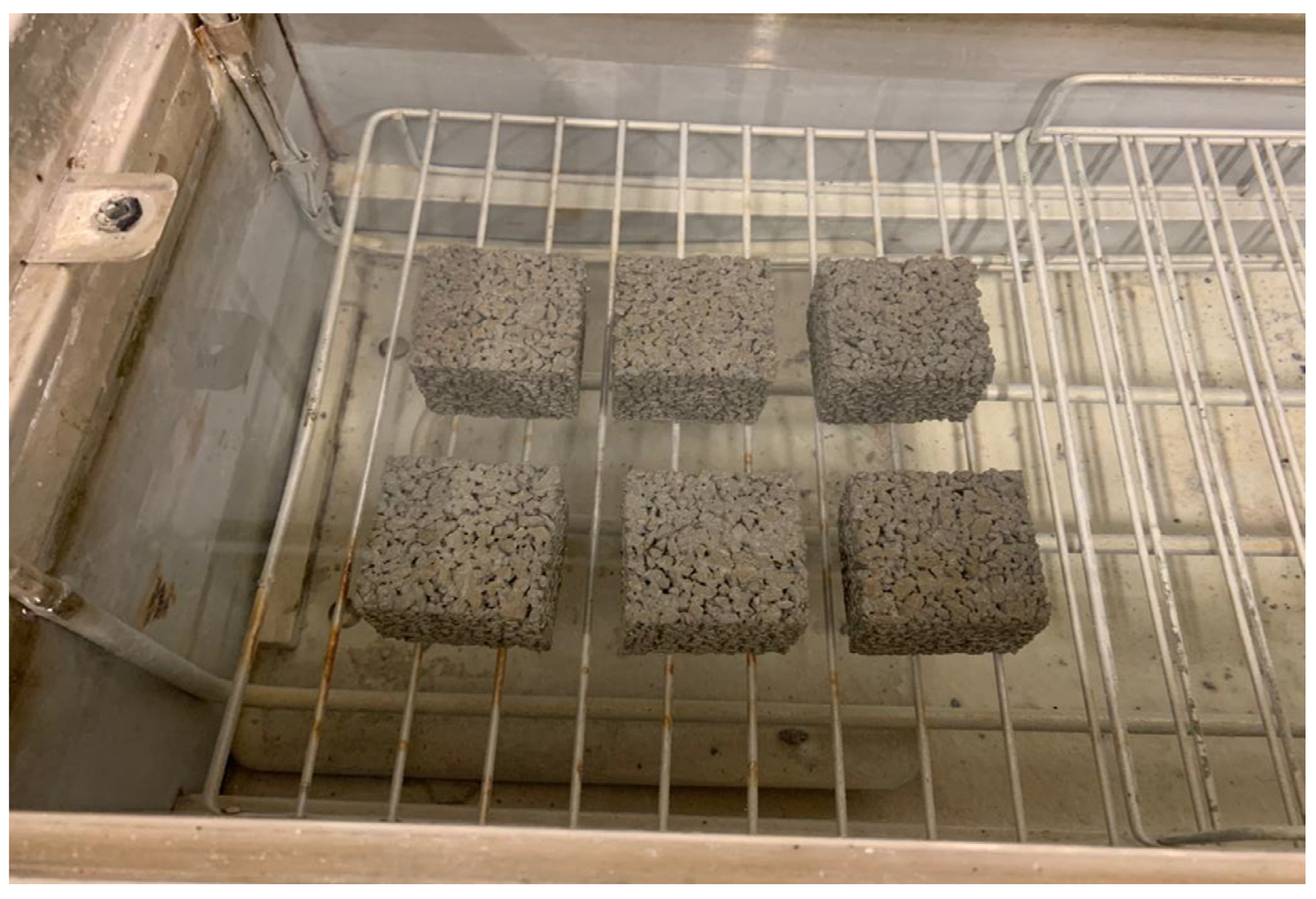
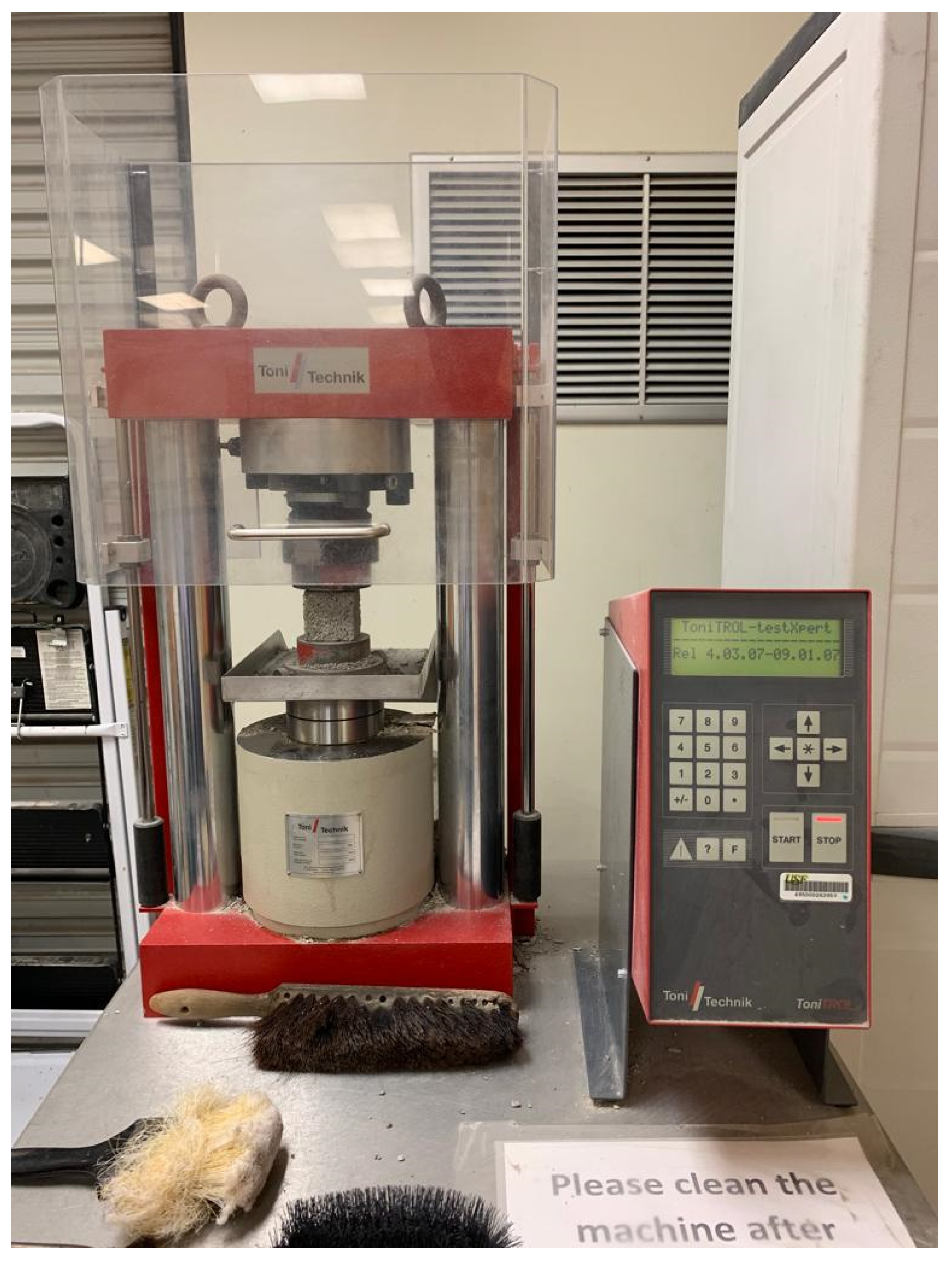
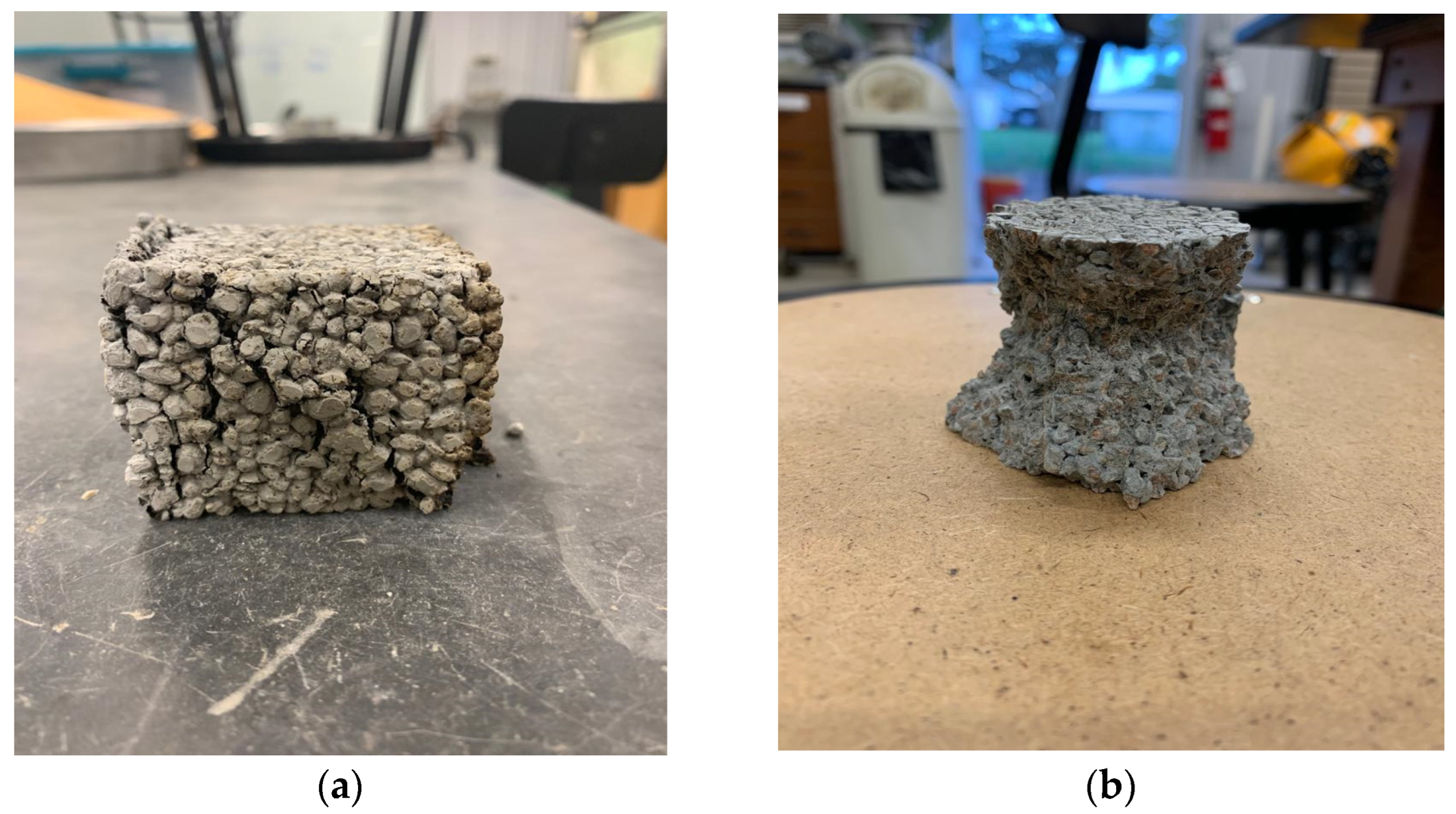
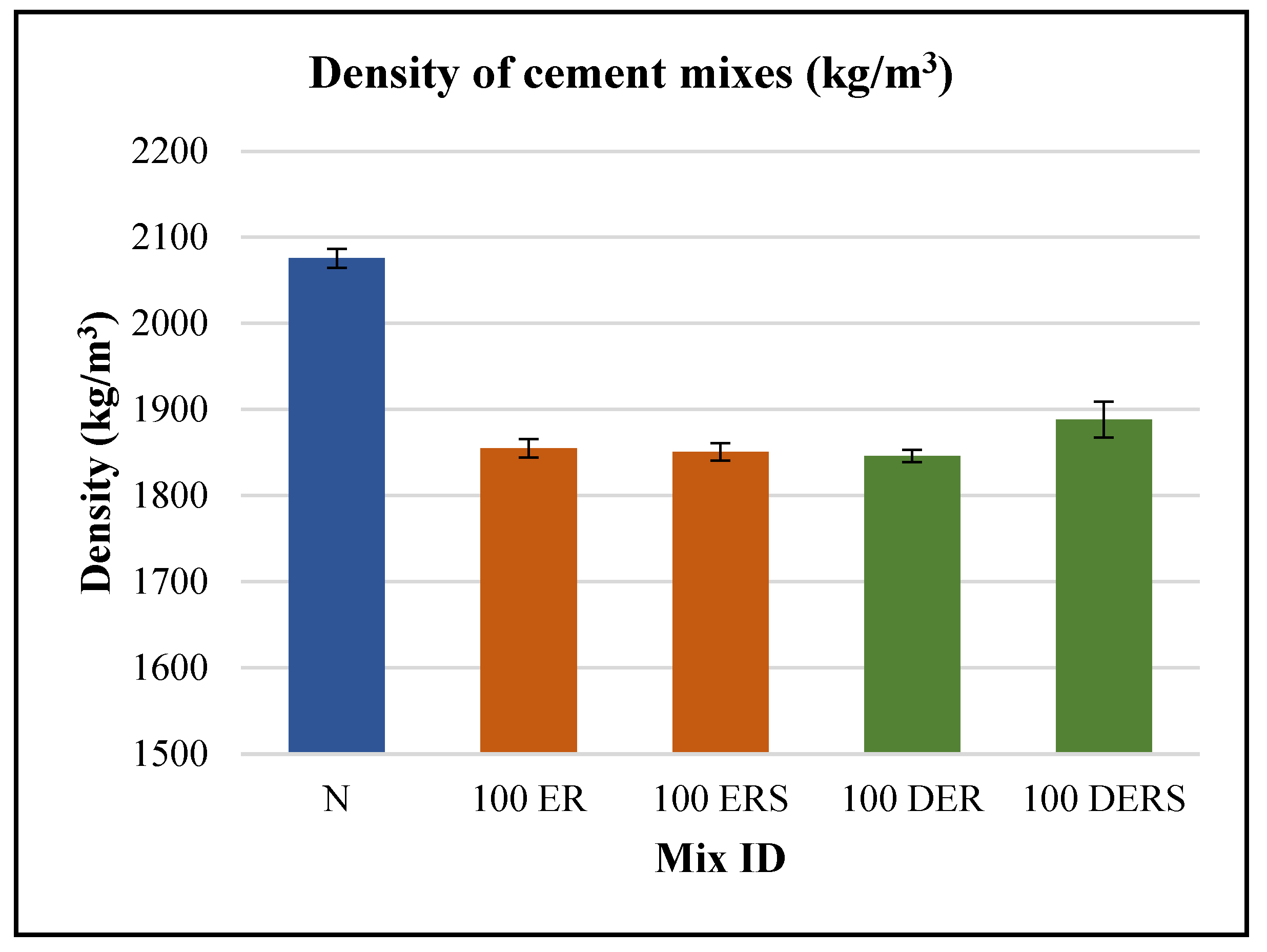
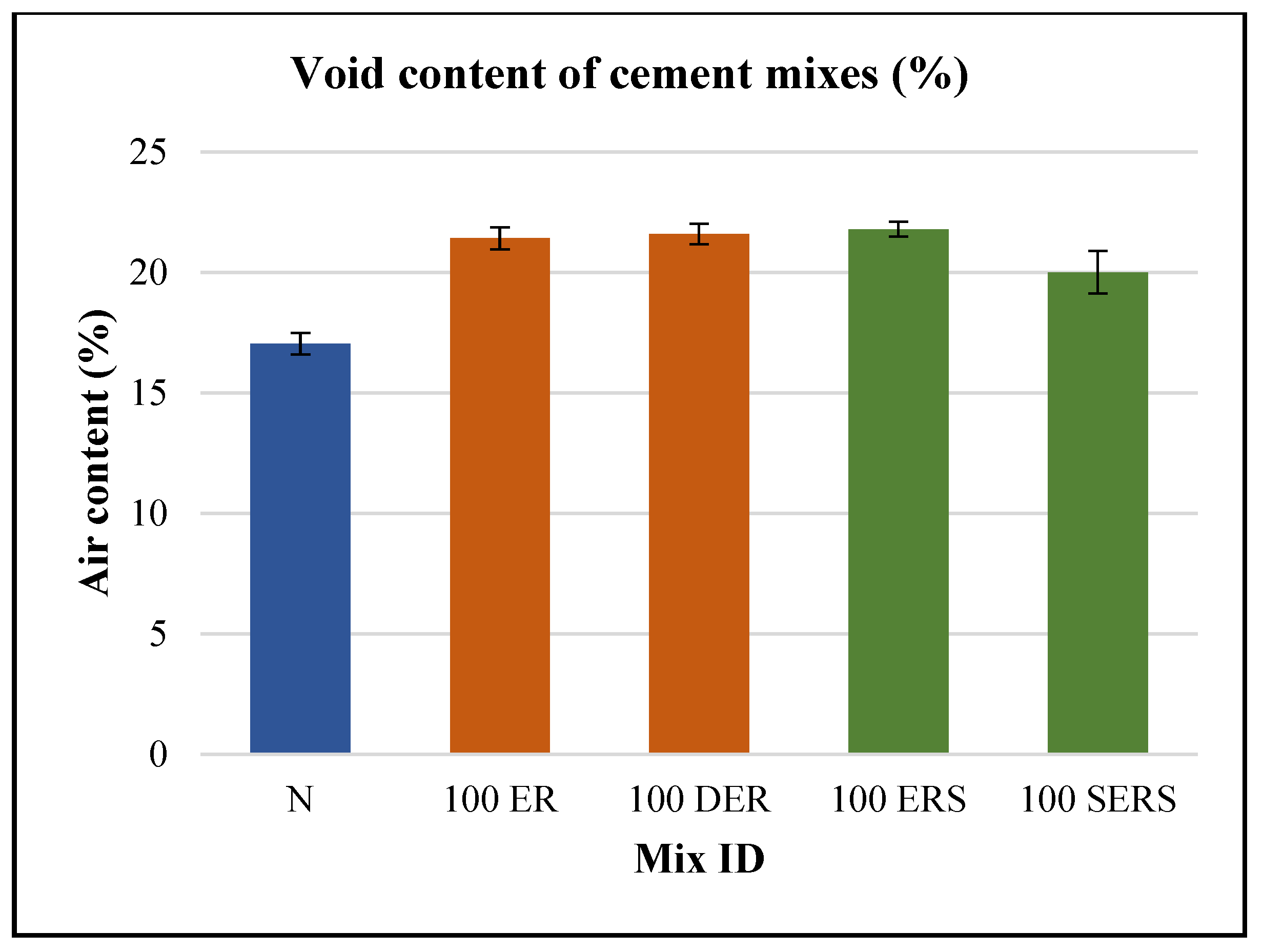


| Cement (kg/m3) | 335.00 |
| Water (kg/m3) | 124.00 |
| Gravel (kg/m3) | 1515.00 |
| Sand (kg/m3) | 106.00 |
| Silica fume percentage by cement mass (%) | 5.00 |
| Water cement ratio | 0.37 |
| Gravel cement ratio | 4.52 |
| Sand gravel ratio | 0.07 |
| Mix ID | Density | Void Content (%) | Permeability (mm/s) | Compressive Strength (MPa) |
|---|---|---|---|---|
| N | 2075.73 | 17.0 | 5.77 | 14.31 |
| ER | 1854.93 | 21.4 | 8.54 | 5.78 |
| ERS | 1850.93 | 21.6 | 5.11 | 5.64 |
| DER | 1846.13 | 21.8 | 9.14 | 6.81 |
| DERS | 1888.31 | 20.0 | 5.69 | 5.85 |
Disclaimer/Publisher’s Note: The statements, opinions and data contained in all publications are solely those of the individual author(s) and contributor(s) and not of MDPI and/or the editor(s). MDPI and/or the editor(s) disclaim responsibility for any injury to people or property resulting from any ideas, methods, instructions or products referred to in the content. |
© 2023 by the authors. Licensee MDPI, Basel, Switzerland. This article is an open access article distributed under the terms and conditions of the Creative Commons Attribution (CC BY) license (https://creativecommons.org/licenses/by/4.0/).
Share and Cite
Alamri, M.; Lu, Q.; Elmagarhe, A.; Elnihum, A. The Effect of Incorporating 100% of Undiluted and Diluted Reclaimed Epoxy Asphalt Materials into Pervious Cement Mixes. Coatings 2023, 13, 1178. https://doi.org/10.3390/coatings13071178
Alamri M, Lu Q, Elmagarhe A, Elnihum A. The Effect of Incorporating 100% of Undiluted and Diluted Reclaimed Epoxy Asphalt Materials into Pervious Cement Mixes. Coatings. 2023; 13(7):1178. https://doi.org/10.3390/coatings13071178
Chicago/Turabian StyleAlamri, Mohammed, Qing Lu, Asad Elmagarhe, and Ahmed Elnihum. 2023. "The Effect of Incorporating 100% of Undiluted and Diluted Reclaimed Epoxy Asphalt Materials into Pervious Cement Mixes" Coatings 13, no. 7: 1178. https://doi.org/10.3390/coatings13071178
APA StyleAlamri, M., Lu, Q., Elmagarhe, A., & Elnihum, A. (2023). The Effect of Incorporating 100% of Undiluted and Diluted Reclaimed Epoxy Asphalt Materials into Pervious Cement Mixes. Coatings, 13(7), 1178. https://doi.org/10.3390/coatings13071178








